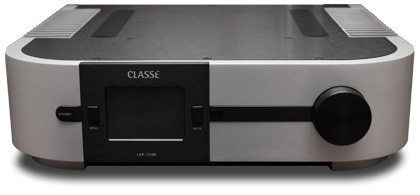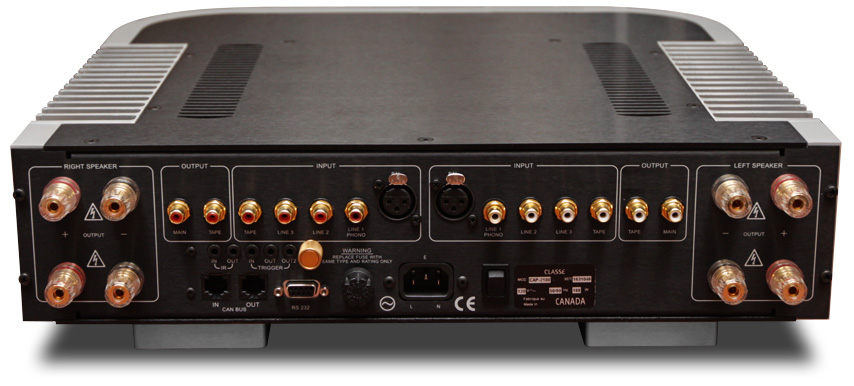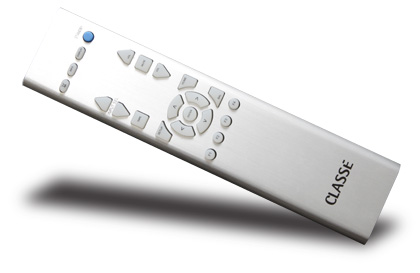 November 2009
Classé Audio Delta CAP-2100
Integrated Amplifier

| Associated Equipment Speakers -- Magico V2, PSB Synchrony One, Definitive
Technology Mythos STS SuperTower, Paradigm Reference Signature S1 v.2
Preamplifiers -- Blue Circle Audio BC3000
Mk.II, Benchmark Media DAC1 HDR, Anthem Statement D2v
Power amplifiers -- Blue Circle Audio BC204,
Axiom Audio A1400-8
Integrated amplifier -- Zandèn Audio 600
Digital sources -- Simaudio Moon Evolution
SuperNova CD player, Benchmark Media DAC1 HDR DAC, Stello DA220 Mk.II DAC, Blue Circle Audio
BC501 DAC
Speaker cables -- Nirvana Audio S-L, DH Labs
ST-100
Analog interconnects -- Nirvana Audio S-L,
Nordost Quattro Fil
Digital interconnects -- Nirvana Audio
Transmission Digital, i2Digital X-60 |
|
|
|
Reviewers and consumers tend to
gravitate toward the latest and greatest -- it’s fresh, it’s exciting, and maybe
it’s on the cutting edge. But newer doesn’t always mean better,
and that’s particularly true of amplifiers; technology in this area doesn’t
change much. Amplifiers that have been on the market for a while and are still readily
available, also deserve consideration.
It was with this in mind that I asked Classé Audio to send
me a review sample of an integrated amplifier that they introduced in summer 2004. Classé
was founded in 1980 and is based in Montreal, Quebec, Canada; the CAP-2100 ($5500 USD),
part of their well-regarded Delta line, is currently the only integrated amplifier the
company makes.
Description
The Delta CAP-2100 measures 17.5"W x 4.75"H x
16.5"D and weighs 50 pounds. The elegantly curved, silver aluminum panels that
surround the front and sides looked unconventional, even radical, when the Delta line was
introduced five years ago; now, though no longer new, the look has successfully stood the
test of time -- I liked the Deltas’ simple yet sophisticated styling in 2004, and I
like it just as much today.
The CAP-2100 isn’t only nice to look at; it’s
built exceptionally well, feels sturdy, and has good appointments: solid-aluminum feet
with Navcom LimbSaver material on the bottom to reduce vibrations; unobtrusive heatsinks
inset on the side; and top-quality speaker connectors on the rear. All of these aid
performance, but have been implemented in ways that complement the appearance and help
give the CAP-2100 a high-end look and feel appropriate to its not-insubstantial price.
Commensurate with the CAP-2100’s solid build is its
stout output capability -- Classé claims 100Wpc into 8 ohms or 200Wpc into 4 ohms. The
fact that the CAP-2100’s power output doubles as the impedance halves indicates good
current capability, which in turn means that it should be able to control most speakers,
even those presenting a tougher-than-normal load.
According to Classé’s literature, the CAP-2100 has
three separate power supplies, one each for the power amp, preamp, and control sections.
The three transformers are near the front of the chassis -- when you lift the CAP-2100,
it’s front-heavy. The circuit boards have been laid out to optimize performance: the
preamp section is toward the rear, nearest the connectors, while the digital-control
circuits are toward the center, to keep them away from the analog signal paths.
On the rear panel are three sets of single-ended inputs,
one set of balanced inputs, one set each of single-ended tape inputs and outputs, and one
set of single-ended preamplifier outputs. An optional internal phono stage, available as a
kit for $500, occupies the first single-ended input spot if you choose to add it. With the
popularity of turntables these days, some buyers undoubtedly will.
Also on the rear panel are the main power switch, the
power-cord receptacle, a trigger input and two trigger outputs, two sets of high-quality
speaker binding posts for each channel to ease biwiring, an infrared remote-control jack,
and, finally, Classé’s CAN BUS input and output ports, to communicate with other
Classé components and make for more efficient system operation. I had no other Classé
products on hand and so didn’t use the CAN BUS, but was told that standby status,
display intensity, input selection, and other functions can be controlled from component
to component with it.

The front panel is sparse, in keeping with the simple,
elegant design. The dominant features are, toward the left, the display -- a small TFT
(thin-film transistor) touchscreen -- and control panel; and, on the right, a large knob
that adjusts the volume in increments of 0.5dB through most of its range (the increments
are larger at the lowest levels, where you don’t need fine-tuning). To the left of
the display are Standby and Menu buttons; to its right is a Mute button.
The volume knob rotates easily and continuously --
there’s no stop point in either direction. In fact, you can spin it freely, yet it
never gets out of control. For example, if you spin the knob superfast, it knows better
than to instantaneously ramp up the volume and destroy your speakers. Instead, the volume
level actually stays about the same, which makes the CAP-2100 more or less child- and
stupid-proof. When the knob is turned at a more reasonable speed, however, the volume
increases. There are no detents to indicate each increment of volume, but the knob has the
right feel; I found it easy to arrive at the right setting. The touchscreen displays the
volume level in large numbers that are easy to read from across the room.
I really like how Classé’s touchscreen system works:
this is where you’ll find not only the typical controls for volume, balance, and
input selection, but handy features for setting your source components’ input levels
(+/-10dB in 0.5dB increments); that way, when you switch between inputs, the volume level
stays roughly the same. Although the touchscreen has no actual buttons, the feel of the
virtual controls is just right, like the volume control, and the arrangement of controls
on the screen makes it easy to use.
 The backlit remote
control of machined aluminum is extremely well made; heavy, but without feeling clunky in
the hand. In controlling all the essentials -- power on/off, volume, input selection,
balance, mute, etc. -- it works as well as the volume knob and touchscreen on the front
panel. The backlit remote
control of machined aluminum is extremely well made; heavy, but without feeling clunky in
the hand. In controlling all the essentials -- power on/off, volume, input selection,
balance, mute, etc. -- it works as well as the volume knob and touchscreen on the front
panel.
I usually test a component’s ease of use by exploring
its features without first reading the instructions. I used every one of the Delta
CAP-2100’s many features without once cracking its manual. It was dead-simple to use
-- a testament to good design. While this kind of functionality and ease of use are common
today, they weren’t in 2004. To impress me with this kind of performance in 2009,
it’s clear that Classé was ahead of their time when they introduced the CAP-2100.
The CAP-2100 comes in exceptional packaging that, like the
amp itself, is attractive and easy to use. It’s not often that the shipping carton is
mentioned in a review, but this one isn’t made of cardboard. Instead, it’s a
plasticky material that’s more resistant to weather, which in my case proved
important -- after the review sample was delivered, it sat on my doorstep for 36 hours.
The box doesn’t open only at the top, but more or less unfolds to reveal the CAP-2100
wrapped in cloth and nestled in a bed of Styrofoam.
All in all, the Delta CAP-2100 is a thoroughly
well-thought-out integrated amplifier with high-end looks, build quality, and
packaging. Now, about the sound . . .
Sound
The Delta CAP-2100 sounded as distinctive and sophisticated
as it looks. Most noticeably, it was smooth through the entire audioband -- I mean super-smooth,
to the point of sounding liquid -- and exceptionally clean, but never clinical or dry.
Like many companies, Classé recommends a burn-in time for their products, but from the
moment I plugged the CAP-2100 in until I finished my listening for this review, these
characteristics never really changed -- and this helped make the CAP-2100 one of the most
pleasing-sounding, nonfatiguing integrated amps I’ve ever heard.
This smoothness meant that the CAP-2100 sounded great with
all types of music, but treated piano and female voices exceptionally well. Sarah
McLachlan’s The Freedom Sessions (CD, Arista 18784) is, in my opinion, her
best album, and many of the songs feature her singing and playing piano in what sounds not
like a studio, but a natural, home-like setting. Whether the actual recording venue was a
house, a studio, or some combination of the two, I have no idea -- but it sounds modest in
size, and you can easily "hear the room." There’s an intimate feel here
that’s missing on her other discs. The CAP-2100 rendered this great recording with
such silky smoothness that I swore I was listening to an amp that had tubes in it
somewhere -- but, of course, without any of the characteristics of traditional, old-school
tube design. The liquidity of tubes was there in spades, but there was enough bass weight
and heft to tell me I was listening to solid-state, and the highs extended effortlessly
and clean without any kind of rolloff.
The CAP-2100’s resolution, its detail, and the
possibility of "hearing into" a recording to make out small nuances and spatial
cues, were as good as I would expect from an excellent integrated amplifier. When I
listened to my longtime reference recording of choral music, Ennio Morricone’s score
for the film The Mission (CD, Virgin CDV2402), I could hear excellent delineation
of the voices -- instead of a wall of undifferentiated vocal sound, the chorus sounded
like a large group of individual singers -- and the spatial information from left to
right, from front to back, and all the way into the corners, was well preserved. For an
integrated amplifier, such levels of resolution and detail are excellent.
In fact, it was clear to me that the only way to better the
Delta CAP-2100’s performance is to move up to higher-quality separate components. Not
just any separates will do -- the CAP-2100 will outperform plenty of preamps and power
amps out there. I haven’t reviewed a Classé preamp-and-power-amp duo, but I have
reviewed the pairing of Simaudio’s Moon Evolution P-7 preamplifier and W-7 power
amplifier, and it supplies an even clearer view into the recording than did the Delta
CAP-2100, rendering subtleties with more detail. However, to get such an increase in
detail, you pay; together, the P-7 and W-7 cost $15,800 -- almost three times as much as
the CAP-2100.
With all the speakers I used with the CAP-2100 --
PSB’s Synchrony One, Definitive Technology’s Mythos STS SuperTower,
Magico’s V2 -- I couldn’t muster up a complaint about this integrated’s
overall sound: ultrasmooth, well extended in the bass and highs, with supreme control, and
a good amount of detail, without ever sounding clinical or cold. I think most people will
react the same way to the CAP-2100; its exceptionally pleasing sound should serve them
well.
But that doesn’t mean the CAP-2100 was flawless, or
will be perfect for everyone. A few small concerns buyers should be aware of:
The CAP-2100’s 100Wpc output will be sufficient for
most people, and its ability to drive difficult loads is good enough that it will match
well with most speakers. The powered bass section of the Mythos STS SuperTower makes this
speaker pretty easy to drive, and the CAP-2100 did just fine. In fact, its smooth sound
helped tame the STS’s occasionally edgy top end. But Magico’s V2, which needs
gobs of power to do its best, and PSB’s Synchrony One -- which doesn’t only
present an amplifier with a low impedance but seems a tricky load as well, and has
surprised me by driving into clipping some pretty powerful amps -- were a little
different. The CAP-2100 worked well enough with those two power-hungry speakers; the sound
was always very good, and I never got it to clip. However, what was missing was the
effortlessness of sound that a much-higher-powered amp can provide -- that feeling of
there being almost limitless power in reserve, even if you’re not using it.
Not that long before the CAP-2100 arrived, I reviewed
Classé’s CA-5200 power amp ($9000), which is rated to deliver 200W to each of its
five channels. I used it in my main system with an Anthem Statement D2v
preamplifier-processor. A doubling of amplifier power produces only 3dB more output from
the speakers. That shouldn’t seem like a big difference, but you don’t only get
more output; with power to spare, there’s greater weight, presence, heft --
everything just sounds bigger. It’s like putting a more powerful engine in your car.
When the CAP-2100 drove speakers that present a tougher-than-average load, it held its
own, but I knew it was working hard. When the CA-5200 takes on the same load, it coasts.
This quality of sound is hard to describe, but you know it when you hear it. That said,
this isn’t so much a criticism as a clarification of the obvious: While a 100Wpc
integrated can provide a lot of performance, it won’t be the perfect amp for every
listener and every loudspeaker.
The next thing is more of a criticism: the Delta
CAP-2100’s slight lack of what I call attack. The CAP-2100’s smooth,
liquid sound was so easy on my ears that I could swear I was listening to as pleasing a
tube amp as I’ve ever heard. But also like a tube amp, the Classé’s sound
wasn’t forceful, incisive, or visceral, even with sensitive speakers that are easy to
drive. Its seductive smoothness seemed to be a result of a slight "rounding" of
the sound; this was most noticeable in the bass, but I heard it in the midrange, too. The
low end went deep, but the drumming on a hard-driving song such as Shakira’s
"Objection (Tango)," from her Laundry Service (CD, Sony 63900),
wasn’t as impactful as I’ve heard with other like-powered solid-state amps, let
alone what I heard from Classé’s own CA-5200. I think this has something to do with
power output -- but I hear this same "rounding" with higher-sensitivity speakers
and at moderate volume levels, so I believe it’s also inherent in the CAP-2100’s
design. Overall, the CAP-2100 emphasized smoothness and ease of sound over
solid-state’s typical crispness and speed. Those who like incisiveness and excitement
might find that the CAP-2100 errs too much on the side of politeness.
Conclusion
It’s no wonder that Classé Audio’s Delta
CAP-2100 has remained unchanged for so long. Its appearance is no longer as novel as it
was five years ago, but even if the look isn’t new, I find it just as attractive as I
did then -- a hallmark of great industrial design. Its functionality is excellent, and its
ease of use, even by today’s standards, is topnotch. There are plenty of feature-rich
integrated amplifiers today, but I know of none that’s easier to use.
And the most important thing about the CAP-2100 -- its
sound -- isn’t outdated at all. The CAP-2100’s seductive smoothness throughout
the audioband is reminiscent in ways of the silky sound of tubes, but with proper bass and
high-frequency extension. Where the CAP-2100 falls down a touch, it does so gently and
inoffensively -- it’s more polite and forgiving than upfront and aggressive.
Had I reviewed the CAP-2100 five years ago, when it was
launched, I probably would have talked more about what was then a radical new look, and a
plethora of features rare at the time. But my enthusiasm for its sound would have been the
same. Classé’s Delta CAP-2100 is a thoroughly well-executed integrated amplifier
whose appearance, ease of use, and sound leave no question as to why it has survived long
in the marketplace. It’s an extremely good integrated amplifier that, at its very
reasonable price, is still competitive today.
. . . Doug Schneider
das@soundstage.com
Classé Audio Delta CAP-2100 Integrated Amplifier
Price: $5500 USD (add $500 for optional phono stage).
Warranty: Five years parts and labor.Classé
Audio, Inc.
5070 François Cusson
Lachine, Québec H8T 1B3
Canada
Phone: (514) 636-6384
Fax: (514) 636-1428
E-mail: cservice@classeaudio.com
Website: www.classeaudio.com |
|

